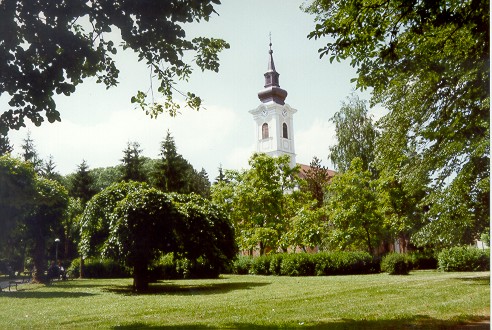- Petrinja
Infobox Settlement
official_name = Petrinja
settlement_type = Town
image_caption = Park in Petrinja
image_shield =
pushpin_
map_caption = Location of Petrinja in Croatia
subdivision_type = Country
subdivision_name =Croatia
subdivision_type1 = County
subdivision_name1 = Sisak-Moslavina
area_total_km2 =
population_as_of = 2001
population_note =
population_total = 13801
latd = 45
latm = 26
latNS = N
longd = 16
longm = 17
longEW = E
leader_title = Mayor
leader_name = Miroslav Gregurinčić (independent)
timezone = CET
utc_offset = +1
timezone_DST =CEST
utc_offset_DST =+2
notes =Petrinja is a town in central
Croatia nearSisak in the historic region of Banovina. The city belongs toSisak-Moslavina County (Sisačko-moslavačka županija).West of Petrinja is
Petrova gora (Peter's mountain), site of theBattle of Gvozd Mountain between KingPetar Svačić of Croatia and Coloman of Hungary.Demographics
The population of Petrinja is 13,801, while the total municipality population is 23,413 (census 2001) [cite web |title=Census 2001 |url=http://www.dzs.hr/Eng/censuses/Census2001/census.htm |author=Central Bureau of Statistics] .
History of Petrinja
The name of Petrinja has its roots in
Latin petrus - stone. It is said that the town existed in Roman era in the area of Zrinska Gora, which is very rich in stone.The first written trace of Petrinja as an inhabited settlement is the one about the benefits awarded to the inhabitants of Petrinja by the
Slavonia n dukeKoloman in the year of 1240. This old medieval Petrinja belongs to the time of warring with the Turks. In 1592, Petrinja was given a new location with the construction and building of a Turkish fortress at the confluence of the Petrinjčica and the Kupa rivers. The fortress was to serve the Turks in conqueringSisak ,Turopolje andZagreb .In 1594, on St. Lawrence's Day (August 10 ), the fortress was first liberated by the Croatian army. Therefore,August 10 has become the day of gratitude towards God and St. Lawrence, and this saint has been chosen for the patron saint of the parish and the town of Petrinja. Over the time, Petrinja has increasingly become the place of the settlement for many craftsmen and merchants whose arrival marks the beginning of the town's development.Petrinja was part of
Napoleon 'sIllyria from 1809 till 1813 when the town became a significant trade and traffic center. In the same period, the French army planted the lindens that even today testify to the town's historical moment.The first Catholic parish Church of St. Lawrence was first built in 1603, but due to the time and type of building, a new one was built in 1781, in late
baroque —classicist style. During the [http://video.google.com/videoplay?docid=6941203404408695012&hl=en Serb occupation of Petrinja] during theCroatian war of Independence , which lasted from 1991 till 1995, the rebellious Serbs demolished the parish church to the ground, as well as all other sacral buildings and sights. After returning to their town, the inhabitants of Petrinja have reconstructed and rebuilt the church according to the sketches and blueprints of the old building, thus resuming the original function of this part of the town.The foundations of the "Prva hrvatska tvornica salame, sušena mesa i masti" (first Croatian salami, dried meat and processed fat factory) were set in the year
1792 , now developed into the "Gavrilović" factory, the principal factor of the area's economic development, well-known for the quality of its gastronomical products. The influence of Croatian national revival in the 19th century was felt in Petrinja. That was the time of the founding of the Town Orchestra (1808), Music Department (1841), Library and reading-room (1842), Teachers' Training School (1862), Croatian Choir "Slavulj" (1864), Town fire-brigade (1880), First printing-house (1881).Recent history has witnessed the Serb aggression on Croatia during which the people were exiled from their hometown of Petrinja in the period from September 1991 till May 1995. The town itself has been through a very grave destruction. Beholding Croatian identity, many monuments have been erected in memory of the Croatian war heroes and victims of the war. In reconstructing and rebuilding their town, the inhabitants of Petrinja took great care of the town's urban tradition by keeping the old customs alive, celebrating Catholic holidays, and organizing numerous cultural, social and sports events.
There is a very lively tradition of the potting and ceramic crafts, which represent the main souvenir production of the items characteristic for this area, all made of high quality clay. The main souvenir is "stucka", an ornamented multi-use jar made of clay that has become a symbol of the town of Petrinja.
Notable people
*
Janko Grahor (1827.-1906.), architect
*Krsto Hegedušić (1901.-1975.), artist
*Branko Horvat (1928.-2003.), economist and politician
*Oton Kučera (1856.-1931.), astronomer
*Drago Roksandić (1948-), historianReferences
External links
* [http://www.petrinja.hr/ Official web site of Petrinja]
* [http://www.petrinja.net/ Petrinja.net (in Croatian)]
* [http://www.petrinja.com/ Petrinja Online (in Croatian)]
* [http://www.tzg-petrinja.hr/EindexGB.htm Petrinja Tourist Office]
Wikimedia Foundation. 2010.

